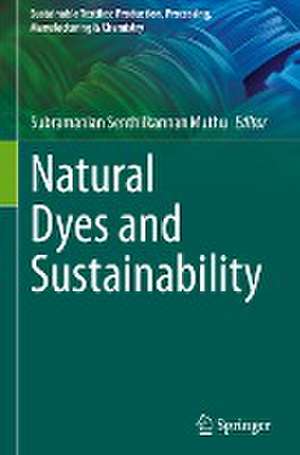Natural Dyes and Sustainability: Sustainable Textiles: Production, Processing, Manufacturing & Chemistry
Editat de Subramanian Senthilkannan Muthuen Limba Engleză Hardback – 24 ian 2024
Din seria Sustainable Textiles: Production, Processing, Manufacturing & Chemistry
- 24%
 Preț: 778.71 lei
Preț: 778.71 lei - 18%
 Preț: 726.37 lei
Preț: 726.37 lei - 20%
 Preț: 567.99 lei
Preț: 567.99 lei - 20%
 Preț: 692.85 lei
Preț: 692.85 lei - 18%
 Preț: 790.28 lei
Preț: 790.28 lei - 18%
 Preț: 1002.61 lei
Preț: 1002.61 lei - 18%
 Preț: 951.29 lei
Preț: 951.29 lei - 18%
 Preț: 781.62 lei
Preț: 781.62 lei - 18%
 Preț: 895.45 lei
Preț: 895.45 lei - 15%
 Preț: 583.93 lei
Preț: 583.93 lei - 15%
 Preț: 694.04 lei
Preț: 694.04 lei - 15%
 Preț: 637.46 lei
Preț: 637.46 lei - 15%
 Preț: 575.77 lei
Preț: 575.77 lei - 15%
 Preț: 576.09 lei
Preț: 576.09 lei - 15%
 Preț: 578.05 lei
Preț: 578.05 lei - 15%
 Preț: 637.78 lei
Preț: 637.78 lei - 15%
 Preț: 579.34 lei
Preț: 579.34 lei - 15%
 Preț: 701.72 lei
Preț: 701.72 lei - 15%
 Preț: 642.64 lei
Preț: 642.64 lei - 18%
 Preț: 948.79 lei
Preț: 948.79 lei - 15%
 Preț: 575.09 lei
Preț: 575.09 lei - 15%
 Preț: 696.68 lei
Preț: 696.68 lei
Preț: 806.76 lei
Preț vechi: 1061.53 lei
-24% Nou
Puncte Express: 1210
Preț estimativ în valută:
154.39€ • 167.65$ • 129.69£
154.39€ • 167.65$ • 129.69£
Carte tipărită la comandă
Livrare economică 19-25 aprilie
Preluare comenzi: 021 569.72.76
Specificații
ISBN-13: 9783031474705
ISBN-10: 3031474708
Pagini: 354
Ilustrații: VIII, 354 p. 182 illus., 98 illus. in color.
Dimensiuni: 155 x 235 mm
Greutate: 0.79 kg
Ediția:1st ed. 2023
Editura: Springer Nature Switzerland
Colecția Springer
Seria Sustainable Textiles: Production, Processing, Manufacturing & Chemistry
Locul publicării:Cham, Switzerland
ISBN-10: 3031474708
Pagini: 354
Ilustrații: VIII, 354 p. 182 illus., 98 illus. in color.
Dimensiuni: 155 x 235 mm
Greutate: 0.79 kg
Ediția:1st ed. 2023
Editura: Springer Nature Switzerland
Colecția Springer
Seria Sustainable Textiles: Production, Processing, Manufacturing & Chemistry
Locul publicării:Cham, Switzerland
Cuprins
Chapter 1. Natural dyes in Traditional textiles – A gateway to sustainability.- Chapter 2. SUSTAINABLE EXTRACTIONS AND APPLICATIONS OF NATURAL DYESTUFFS.- Chapter 3. Dyes and pigments from agricultural wastes in the coloration of textiles.- Chapter 4. Recent approaches and advancements in natural dyes.- Chapter 5. Mushroom based natural dyes for sustainable color in textiles.- Chapter 6. Extraction and Application of Tannin Based Plants As Source Of Natural Colourants.- Chapter 7. SOCIAL AND ENVIRONMENTAL IMPACT OF NATURAL DYEING.- Chapter 8. Classification of Natural Dyes for Sustainable Exploitation.- Chapter 9. Natural Indigo dyes – A potential dye for sustainability.- Chapter 10. NATURAL DYES – COLOURING TOOL FOR TEXTILES.- Chapter 11. Extraction of Natural Pigments Using Supercritical Carbon Dioxide and its Application on Different Fabrics.- Chapter 12. Natural Dyes as Corrosion Inhibitors.- Chapter 13. Evaluation of Colorimetric and Color Fastness Properties of Marble PrintedSilk Fabrics with the Usage of Various Mordants and After Treatments.- Chapter 14. Natural dyeing of PA 6, PTT, PBT, PLA, Silk, and Soybean textile fibers with black mulberry fruit extract by conventional and microwave dyeing techniques.
Notă biografică
Dr. Subramanian Senthilkannan Muthu is currently the Chief Sustainability Officer at Green Story Inc, Canada, based out of Hong Kong. He earned his PhD from The Hong Kong Polytechnic University, and is a renowned expert in the areas of Environmental Sustainability in Textiles & Clothing Supply Chain, Product Life Cycle Assessment (LCA) and Product Carbon Footprint Assessment (PCF) in various industrial sectors. He has five years of industrial experience in textile manufacturing, research and development and textile testing and over a decade's of experience in life cycle assessment (LCA), carbon and ecological footprints assessment of various consumer products. He has published more than 100 research publications, written numerous book chapters and authored/edited over 150 books in the areas of Carbon Footprint, Recycling, Environmental Assessment, Life Cycle Assessment and Environmental Sustainability.
Textul de pe ultima copertă
Natural dyes offer a time-tested and generally more sustainable alternative to synthetic dyes in the textile industry. The issues surrounding synthetic dyes are well-known, and in the literature it is generally accepted that natural dyes have a smaller environmental impact. However, even natural dyes have issues that must be dealt with in order to ensure sustainability in the industry. For example, the mordants needed to improve the dyeing process may release hazardous heavy metal pollutants when used. This book is dedicated to exploring cases such as this that illustrate the benefits and drawbacks to natural dyes and steps that must be taken for their sustainable use in the textile industry.
Caracteristici
Describes sustainability benefits of natural dyes vis a vis synthetic dyes Offers concepts related to natural dyes and case studies in their application Discusses color fastness of natural dyes
